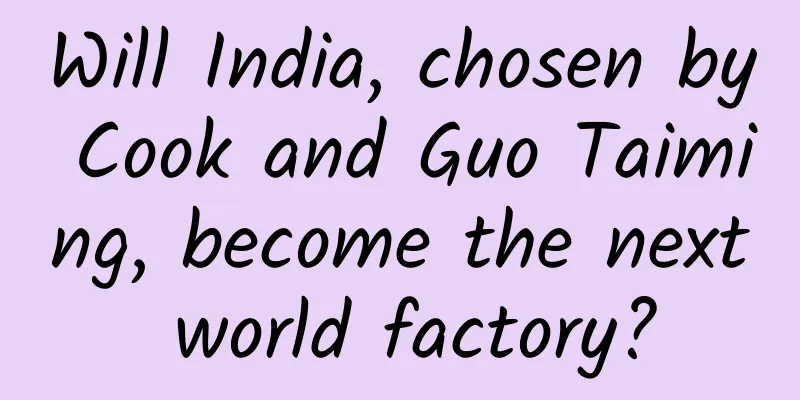Will India, chosen by Cook and Guo Taiming, become the next world factory?

|
Indians like to call their country "Incredible India", which is always an indispensable stop on the journey of seeking the true meaning of life. But now, India's label may soon be added with "Made in India". Both Foxconn, a global consumer electronics OEM giant, and Apple, which has topped the global market value list many times, have recently shown a strong interest in India. Last Saturday, Apple CEO Tim Cook met with Indian Prime Minister Narendra Modi in New Delhi and said he was seriously considering "moving iPhone production to India." A few days ago, Cook had just attended a developer forum on Apple Store in China and climbed the Great Wall, but in India, he spent more time on "business negotiations." A noteworthy background is that Apple's sales in India soared 56% in the first quarter of this year amid the global trend of slowing smartphone sales. Compared with Apple, global contract manufacturer Foxconn seems to be more active. Since last year, with more than a dozen manufacturing plants, $20 billion in investment, and involvement in industries such as renewable energy and e-commerce, this manufacturing giant's ambitions for India are clearly not just one or two projects. The potential of the Indian market is immeasurable. "India is a very large potential market, and the economies of China and India are highly complementary. But the current trade volume between the two countries is only US$70 billion, which is still very small compared to such a large market, such a large country, and such a large population," Yan Hualong, deputy consul general of China in Mumbai, told a reporter from China Business News at an international economic and trade cooperation forum. In fact, with the intensification of China's manufacturing overcapacity and rising labor costs, the migration of manufacturing companies to India seems inevitable. From the collective establishment of factories in India by mobile phone manufacturers last year to the joint visit of Apple's industrial chain to India, the "next world factory" seems to have taken shape. However, the question is, will it replace "Made in China"? “Moving production lines to India” Cook's trip to India continues and is going well. Cook accepted an exclusive interview with Indian TV media NDTV last Friday. In the 40-minute interview, Cook showed his ambition to develop the Indian market and talked in detail about important measures for this market, including considering moving the company's "entire" production line to this potential huge market. According to a reporter from China Business News, Apple sold 51.2 million mobile phones in the first quarter, and is still the world's largest single mobile phone brand. Foxconn, the main foundry responsible for producing Apple mobile phones, currently has production lines concentrated in Shenzhen and Henan, China, involving more than hundreds of thousands of production line workers. If Cook has "seriously" considered moving the production line, it will have a significant impact on the production capacity of Chinese factories. India has long hoped that its large number of cheap laborers would make the country the world's next manufacturing engine after China, but India's ambitions are constrained by poor infrastructure and complex labor regulations. However, with the rise of Narendra Modi, India's overall manufacturing environment is improving. In the previous election campaign, Modi promised to create jobs for the 10 million to 12 million Indians who enter the job market every year, and manufacturing has become the first horse to pull employment. It is reported that during the talks, Cook explained to Modi Apple's future plans in India. He said that a new iOS application design and development accelerator will be established in Bangalore, India, and a map R&D center will be launched in Hyderabad. Modi hopes that the technology giant Apple can contribute to the "Digital India" project. "Digital India" is the most critical project of the Modi government at present, and its purpose is to lead India's transformation into a digital-driven society and knowledge economy. In fact, as early as last year, Foxconn expressed its support for "Make in India", saying that it saw "huge potential" in building Chinese-style factory facilities in India. In multiple contacts with reporters, Foxconn's global spokesperson said that it was negotiating with the local government in India about cooperation on manufacturing plants. "The group will build its first batch of production plants in five states, including Andhra Pradesh, Gujarat and Maharashtra, and will expand its factory locations to other states in India in the next five years. The group also plans to build data centers and industrial incubation bases in cities such as Delhi, Mumbai, Bangalore and Hyderabad. In addition, Foxconn will also invest in Indian Internet startups, small businesses, and local mobile phone manufacturers." said Terry Gou, chairman of Foxconn. According to the plan, Foxconn will build 10 to 12 production plants in India by 2020 and create at least 1 million jobs. Recently, news appeared in local Indian media that Foxconn acquired 1,200 acres of land in Maharashtra, which means that in a year and a half, Foxconn will most likely produce Apple phones in the region. The next world factory? Exporting China's industrial capacity overseas is now an inevitable trend. Taking mobile phone manufacturers as an example, many brand manufacturers have begun to set up factories and recruit employees in India. "We have decided to invest and build a factory in India near Delhi," Lu Weibing, president of Gionee Mobile, told a reporter from China Business News. According to previous information, vivo has negotiated with the Indian government and obtained approval. Insiders revealed that in the next 3 or 4 years, vivo may open a factory in Girgaon, India. In an interview with our reporter, Zhao Ming, president of Huawei Honor, also said that Huawei is brewing new plans for the Indian market and does not rule out building a factory in India. In addition to mobile phone manufacturers, more electronic information technology companies have already entered India one step ahead. Haryana is located in the northwest of India. In addition to traditional agriculture and industry, the electronic information industry is emerging in the region. For example, Samsung, IBM, General Electric, and Tata have set up branches in major cities such as Gurgaon, the largest city in the state. Among Chinese companies, ZTE has reached an investment intention with Haryana for its smart city construction plan, and data service provider Inspur Group also plans to invest US$100 million to establish a branch in the state. However, during the reporter's visit, it was found that due to the relatively complete domestic production lines, trade imports may be more suitable for domestic mobile phone manufacturers to enter the Indian market. Generally speaking, from placing an order to warehousing in the Indian warehouse, the order turnover cycle is about 8 days, and transshipment from Hong Kong, China is very convenient. Regarding the cost comparison between China and India, a Chinese mobile phone agent in India told China Business News that many manufacturers increased their investment in factories in India due to India's continuous adjustment of import tariffs. "Taxes in each state (country) have also been adjusted, which directly affects the profits of mobile phones and peripherals such as chips." It is reported that since March last year, the Indian government has significantly increased the import tax rate for mobile devices from the original 6% to 12.5% in order to encourage the localization of domestic industrial production, while the data obtained by the reporter from the local area is from 2% to 14%. "In comparison, choosing to manufacture locally in India or cooperating with local OEM factories is almost negligible from a tax perspective," a domestic mobile phone manufacturer told reporters. However, Li Dongsheng, Chairman and CEO of TCL Group, believes that building an industrial base locally will help enter the local market and the markets of developed countries. In an interview with reporters, he said that the tariffs on imports from Brazil and India in developed countries are lower than those from China, so overseas bases will also help brand manufacturers enter the markets of developed countries. Dragon and Elephant Battle In the fourth quarter of 2015, India became the fastest growing large economy in the world. In the fourth quarter of last year, China's GDP grew by 6.8%. India is 0.5 percentage points ahead of China. Last year, China's economic growth rate was 6.9%, which was the first time that China's annual GDP growth rate fell below 7% since 1990. In the manufacturing process, Chinese companies are facing inevitable cost pressure. Earlier, a survey data issued by the Boston Consulting Group in the United States showed that the cost of "Made in China" has approached that of the United States. The report analyzed the top 25 economies in terms of global export volume. Taking the United States as the benchmark (100), China's manufacturing cost index is 96, that is, the same product costs $1 in the United States, while it costs $0.96 in China. It can be seen that the gap between the two sides has been greatly narrowed. The report believes that China's manufacturing industry is facing great pressure. Ten years ago, China's manufacturing costs were low, but now the costs have risen sharply. There are three reasons: First, the wages of Chinese workers have increased. China's hourly wage increased from US$4.35 in 2004 to US$12.47 in 2014, an increase of 187%. Second, the exchange rate. From 2004 to 2014, the exchange rate of the RMB against the US dollar increased by 35%. Third, the energy cost. China's electricity consumption increased from US$7/kWh in 2004 to US$11/kWh in 2014, while the cost of natural gas increased from US$5.8/MMBtu to US$13.7, an increase of 138%. In addition, land prices may also be "crazy". In Shenzhen, the innovation capital, the average transaction price of new houses in March this year was as high as 49,989 yuan/square meter, up 3.9% from the previous month. The price of newly built commercial housing rose by 3.7% from the previous month and 62.5% from the previous year. The year-on-year growth rate ranked first in the country for the 16th consecutive month. For Shenzhen, where many electronic companies are gathered, this is not good news. In contrast, India has lower labor costs, which has given rise to products with "greater cost advantages." Previously, in order to seize the Indian smartphone market, Indian local mobile phone manufacturers launched a super low-priced smartphone with an actual selling price of only RMB 24, which attracted attention from all walks of life. Regarding the comparison between China and India, Palepu Krishna, a professor at Harvard Business School who is from India and focuses on the development of emerging markets, said in an exclusive interview with our reporter: "Now many people are concerned about whether India's economic growth rate exceeds that of China, but I think it is somewhat deceptive because India's base is much lower than that of China, so there is still a large gap. Of course, India's attraction also lies in the fact that if you come to India now, you can experience a rapid growth process like China in the past 20 years." However, a person in charge of a Chinese mobile phone manufacturer who did not want to be named told reporters that India currently does not have a mature industrial cluster, and the surrounding costs for building factories in the short term will be relatively high. "In addition, although the manufacturing cost will be lower than that in China, there are still many uncertain factors from the perspective of efficiency and quality, so Chinese manufacturing will still have strong competitiveness in the short term," the person said. As a winner of Toutiao's Qingyun Plan and Baijiahao's Bai+ Plan, the 2019 Baidu Digital Author of the Year, the Baijiahao's Most Popular Author in the Technology Field, the 2019 Sogou Technology and Culture Author, and the 2021 Baijiahao Quarterly Influential Creator, he has won many awards, including the 2013 Sohu Best Industry Media Person, the 2015 China New Media Entrepreneurship Competition Beijing Third Place, the 2015 Guangmang Experience Award, the 2015 China New Media Entrepreneurship Competition Finals Third Place, and the 2018 Baidu Dynamic Annual Powerful Celebrity. |
>>: Can live streaming become VR’s long-awaited killer app?
Recommend
How to tap into iOS channels for app promotion
Question 1: I don’t know where to tap into the iO...
Essentials for GuangDianTong promotion in 2015: Five steps to promote GuangDianTong
The traffic dividend period of major application ...
Where can I buy Black Video Blessing? How much does it cost for black people to send blessing videos?
Where can I buy Black Video Blessing? How much do...
How to build a good community? How to create a community?
I have always believed that community is somethin...
Kuaishou, you can record everyone’s life, but please don’t distort our values!
"In life, there is no distinction between hi...
Ford conducts C-V2X test on open roads in China for the first time
From September 15 to 18, during the 2018 Wuxi Wor...
Brand Communication Plan for 2022
It’s the end of the year, and it’s time for brand...
Zhihu Promotion and Traffic Draining Strategy
Today I will share with you a low-cost, high-retu...
3D simulation technology: a magical power to change the world
When we explore the unknown world, we sometimes e...
Apple submits training plan for operators for new autonomous driving progress
According to Reuters, in a document submitted to ...
This kind of "red bag" is painful and swollen, and it is dangerous to squeeze it! Know these and go to the hospital less often
If we talk about the most painful skin problem, b...
Multi-dimensional analysis of the trend of the "deep learning" market
[[192373]] Industry Analysis In 2016, the global ...
What are the reasons that make whole grains synonymous with health?
Eating too much white rice and white flour will n...
The evolution of smartphones: What will smartphones look like in the next year?
On December 10, Samsung and Huawei Honor both lau...
Xiaohongshu community operation logic!
There is a famous saying in martial arts novels: ...





![[Energy History 01] A ghost in the water and a flower ended the two thousand years of atomic debate](/upload/images/67f26676f2d09.webp)



